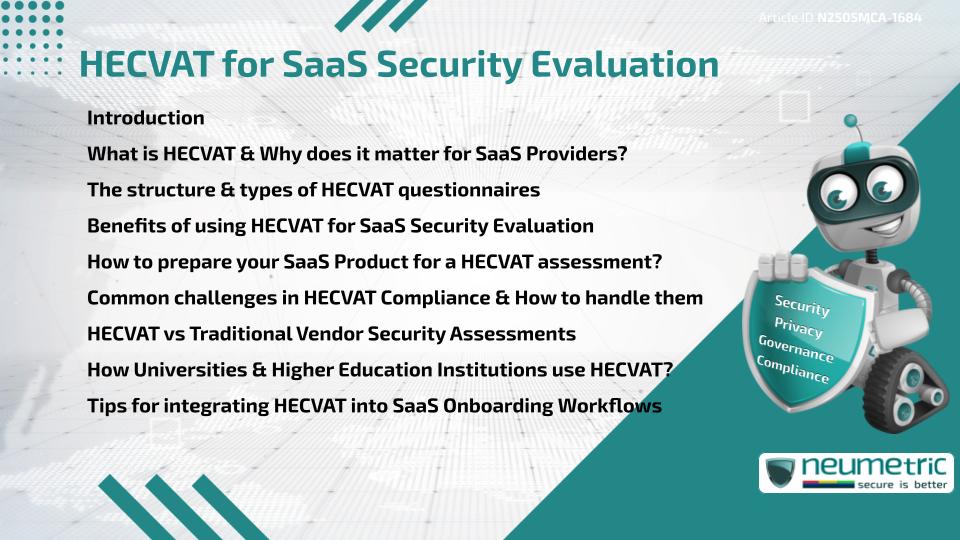Table of Contents
ToggleIntroduction
Software-as-a-Service [SaaS] Companies working with Universities often face a unique challenge—proving that their Security Posture is strong enough to meet Academic Expectations. The Higher Education Community Vendor Assessment Toolkit [HECVAT] is designed to address this. Created by the Higher Education sector, it streamlines Vendor Security Reviews through a common Framework. This article explores the purpose, structure & application of HECVAT for SaaS Security Evaluation, helping Providers better navigate Compliance & Security discussions with Universities.
What is HECVAT & Why does it matter for SaaS Providers?
HECVAT was developed to simplify the Vendor Risk Assessment process in Higher Education. It replaces scattered, inconsistent questionnaires with a unified standard. For SaaS Providers, completing the HECVAT Form is often a precondition to being considered by Universities. It asks specific questions about how a Service manages Data, Security Controls, Access Management & Compliance Practices.
The goal of HECVAT for SaaS Security Evaluation is to create transparency between Vendors & Institutions. Without it, Providers may face longer Procurement Cycles or get ruled out entirely. Many Universities even publish whether a Vendor has completed the HECVAT Questionnaire, affecting Trust & visibility in the Academic Market.
The structure & types of HECVAT questionnaires
HECVAT is not a single document. It consists of multiple versions tailored for different types of Services & levels of Data Risk. The four (4) key types include:
- HECVAT Full – A comprehensive questionnaire for High-Risk Services handling Sensitive Data.
- HECVAT Lite – A shorter form for Low-Risk Services.
- HECVAT On-Premise – Focused on locally Deployed Solutions.
- HECVAT-T – Includes Questions related to Transparency & Ethics.
Each Version is available from the Internet2 HECVAT website, which maintains & updates the Forms regularly.
By selecting the appropriate Version, SaaS Providers can show that their Service meets the specific expectations of Higher Education Institutions without overcommitting.
Benefits of using HECVAT for SaaS Security Evaluation
There are several advantages of using HECVAT in the Vendor evaluation process:
- Efficiency: Instead of custom forms for each Institution, a single HECVAT can be reused.
- Clarity: Questions are written in plain language, making it easier to explain Controls to Non-Technical Stakeholders.
- Trust: A completed HECVAT shows that a Vendor is serious about Security & Transparency.
- Competitive Advantage: Providers who prepare HECVAT Documents in advance are more likely to be shortlisted.
For example, by maintaining a completed HECVAT Full Version, a SaaS Provider can speed up discussions with multiple Universities & reduce the time to Contract.
How to prepare your SaaS Product for a HECVAT assessment?
Preparation begins with understanding the expectations in the HECVAT Questionnaire. Many Questions map directly to established Security Frameworks such as NIST CSF or ISO 27001.
Steps to follow include:
- Assign Ownership: Identify someone who understands both the Product & Security requirements.
- Review the Questions: Choose the right version of HECVAT & read through it carefully.
- Gather Evidence: Collect Policies, Audit Logs, Encryption details & Compliance Certifications.
- Fill Out Thoughtfully: Provide answers with context. Vague responses can raise red flags.
- Validate Internally: Get your Security or Compliance Team to review the completed Form.
These actions align your Internal Policies with what Higher Education Institutions typically require for Vendor Risk Management.
Common challenges in HECVAT Compliance & How to handle them
While helpful, completing HECVAT for SaaS Security Evaluation is not without challenges:
- Misalignment with Internal Terminology: SaaS Teams may use different terms than those found in the HECVAT.
- Gaps in Documentation: Some companies lack formal Policies required by the Questionnaire.
- Security Control Limitations: Not all SaaS Providers have advanced controls such as Data Segmentation or Incident Response Metrics.
To overcome these, start small. Start with the HECVAT Lite Version to establish a baseline & then progress to the Full Version as needed. Working with a Third Party Security Advisor can also help interpret the questions & fill gaps where needed.
HECVAT vs Traditional Vendor Security Assessments
HECVAT differs from Traditional Questionnaires in two major ways:
- Community Ownership: It is designed by & for Higher Education. This brings Relevance & Continuity.
- Transparency & Openness: Many Institutions publicly list Vendors that have completed a HECVAT, creating visibility & accountability.
Traditional Assessments, such as proprietary Checklists or custom Excel Sheets, vary wildly in content & length. These often cause delays & confusion. In contrast, HECVAT provides a consistent format, which benefits both Institutions & Vendors.
How Universities & Higher Education Institutions use HECVAT?
Universities use HECVAT in Procurement to:
- Shortlist Vendors for RFPs
- Assess Risk for data-sharing Partnerships
- Ensure Compliance with FERPA & related laws
- Promote transparency across Department
Being HECVAT-ready means your SaaS Service has cleared a critical hurdle in the Higher Education Sales Cycle.
Tips for integrating HECVAT into SaaS Onboarding Workflows
SaaS Companies can make HECVAT part of their regular Sales & Onboarding process. Here is how:
- Include a link to your completed HECVAT on your Website or Sales Portal.
- Train Sales reps to explain what HECVAT is & how your Service complies.
- Map your answers to Internal Compliance Frameworks to maintain consistency.
By treating HECVAT as part of your Customer Onboarding, you streamline future Sales with Institutions & minimise back-and-forth.
Limitations of HECVAT for SaaS Security Evaluation
Despite its strengths, HECVAT has some limitations:
- Not Universally Accepted: While common, some Institutions still require their own Forms.
- Static Format: The Spreadsheet format can be difficult to manage for large Teams.
- Not Real-Time: Answers may not reflect current Security Incidents or Changes.
Still, these limitations can be managed with regular reviews & updates. Linking HECVAT Answers to your internal GRC System can also help keep responses current.
Takeaways
- HECVAT for SaaS Security Evaluation simplifies security discussions with Universities.
- Completing a HECVAT shows maturity & readiness to handle Sensitive Data.
- Choosing the correct version & preparing supporting evidence are key steps.
- Challenges can be addressed with planning & internal collaboration.
- Making HECVAT part of the Sales process creates competitive advantages in the Academic Sector.
FAQ
What does HECVAT stand for?
HECVAT stands for Higher Education Community Vendor Assessment Toolkit. It is a Security Assessment Tool used by Universities to evaluate Third Party Services.
Why is HECVAT important for SaaS Providers?
HECVAT for SaaS Security Evaluation is important because many Universities require it before engaging with SaaS Vendors. It helps build Trust & ensures Data Protection.
How often should SaaS Providers update their HECVAT Forms?
Ideally, Providers should review & update their HECVAT at least once a year or after any major change in their Security Posture or Technology Stack.
Can HECVAT replace SOC 2 or ISO 27001?
No, HECVAT does not replace Certifications. However, it complements them by showing how a SaaS provider aligns with the specific needs of Higher Education Institutions.
Is the HECVAT mandatory for all SaaS Vendors?
Not universally, but many Academic Institutions strongly prefer or require it, especially for Services that handle Student or Research Data.
Which Version of HECVAT should I choose?
It depends on your Product & Data Handling. HECVAT Lite is for Low-Risk Services while HECVAT Full is for Systems processing Sensitive or Regulated Data.
Are there Tools to help complete HECVAT?
Yes, you can find HECVAT Templates & Guides on the Internet2 Website & work with Advisors familiar with Academic Procurement.
How long does it typically take to complete a HECVAT?
For most SaaS Providers, completing a HECVAT Full can take anywhere from two (2) days to two (2) weeks, depending on documentation readiness.
Need help?
Neumetric provides organisations the necessary help to achieve their Cybersecurity, Compliance, Governance, Privacy, Certifications & Pentesting goals.
Organisations & Businesses, specifically those which provide SaaS & AI Solutions, usually need a Cybersecurity Partner for meeting & maintaining the ongoing Security & Privacy needs & requirements of their Clients & Customers.
SOC 2, ISO 27001, ISO 42001, NIST, HIPAA, HECVAT, EU GDPR are some of the Frameworks that are served by Fusion – a centralised, automated, AI-enabled SaaS Solution created & managed by Neumetric.
Reach out to us!


